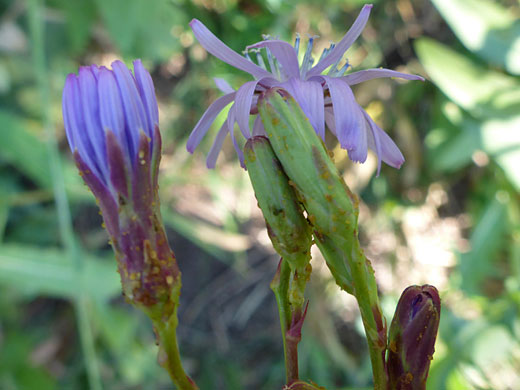
Flower and bud of mulgedium oblongifolium (blue lettuce), along the Mosca Pass Trail in Great Sand Dunes National Park, Colorado
Common name:
Blue lettuce
Family:
Scientific name:
Mulgedium oblongifolium
Synonym:
Lactuca tatarica
Main flower color:
Range:
All the western states
Height:
Up to 40 inches
Habitat:
Varied: moist, low elevation sites; woodland, open plains, hillsides
Leaves:
Narrow, alternate, lanceolate. Those around the base (up to 7 inches long) have large lobes or teeth
Season:
May to August
Mulgedium oblongifolium (formerly lactuca tatarica) is a dandelion-like species with toothed petals and milky sap, growing in scattered areas of all the western states. Stems and leaves are hairless. Leaves grow mostly towards the base. The stem is thick and rigid, branching several times towards the top and (for mature plants) holding dozens of flower heads.
Flowers are a little over an inch in diameter, formed of between 15 and 50 bluish-purple ray florets (no disc florets) and a group of split-topped stamens. The flowers are rather larger than other lettuce species. The involucre is about an inch long, quite thin, surrounded by three overlapping rows of triangular, pointed phyllaries. Leaves are bluish-green in color, and the lower surfaces have a whitish, waxy coating.
Flowers are a little over an inch in diameter, formed of between 15 and 50 bluish-purple ray florets (no disc florets) and a group of split-topped stamens. The flowers are rather larger than other lettuce species. The involucre is about an inch long, quite thin, surrounded by three overlapping rows of triangular, pointed phyllaries. Leaves are bluish-green in color, and the lower surfaces have a whitish, waxy coating.
All Contents © Copyright The American Southwest | Comments and Questions | Contribute | Site Map






